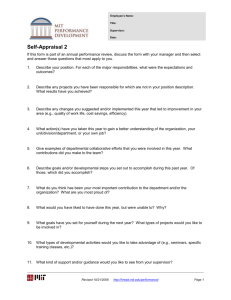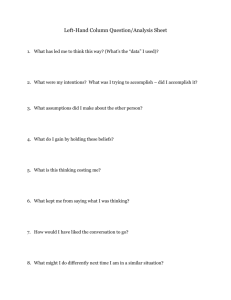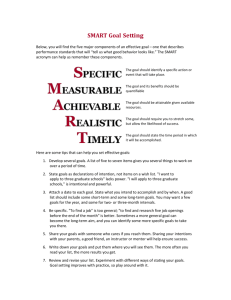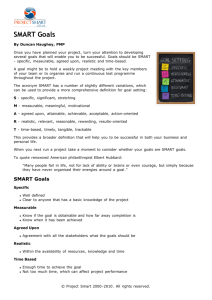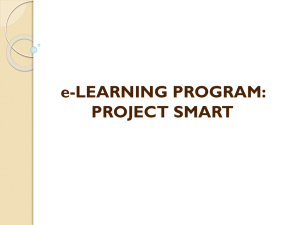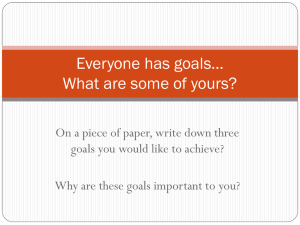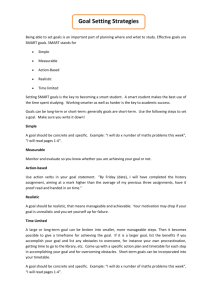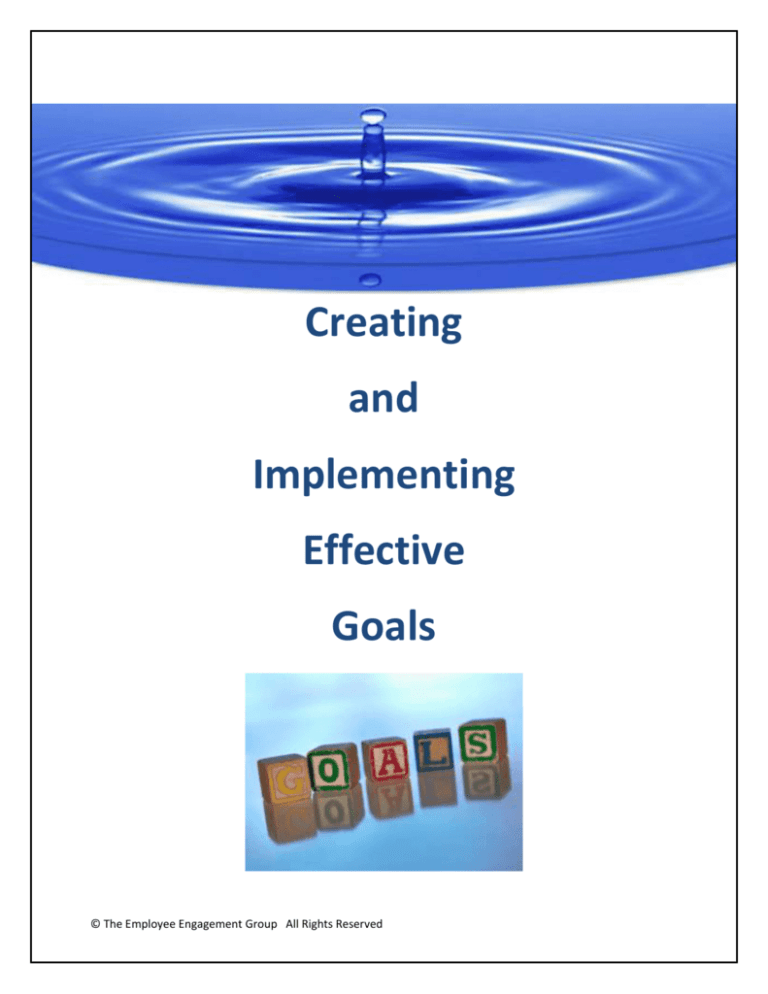
Creating
and
Implementing
Effective
Goals
© The Employee Engagement Group All Rights Reserved
Creating and Implementing Effective Goals
Goals
A goal is an intended outcome or objective which can be established for long-term or short-term
results. Although this worksheet is focused on your job at [COMPANY], goals can be written and applied
to all aspects of your life. The most successful goals are:
Linked to company goals
Written
Reviewed often
Shared
Goals provide direction and identify specific areas of focus. Developed using the SMART model, they
will help establish time frames and specific actions that will help employees be successful.
Types of Goals
There are three types of goals that will be considered for this exercise:
Productivity goals address your day-to-day job functions; these can be both long- and short-term
plans and are often developed during the annual assessment process
Developmental goals are focused on your growth within the company; often developmental goals
include long-term plans
Career goals are the long-term goals that you have within the company for your career beyond
one year. These goals are meant to prompt you to create a clear direction for yourself and
provide your supervisor with your thoughts on the future.
Description of a SMART goal:
A SMART goal is developed by including these components. SMART goals are:
© The Employee Engagement Group All Rights Reserved
Specific
Measureable
Action-oriented
Realistic
Time bound
Specific
Know what you are targeting for your SMART goals and be as specific as you
can. To help determine your direction, consider:
Company, business line, region, department goals
[COMPANY] competencies
Past performance assessments
Supervisor and peer input
Some target areas might be:
Measureable
Sales
Productivity
Utilization
Bookings
Quality
Efficiency
Visibility
Leadership
Communication
Service
Proposals
Writing
SMART goals are measureable in some way. It is important to be able to be
able to measure:
Progress
Completion
Without those measurements, it is difficult to truly identify whether the goal
has been accomplished successfully. For instance, a goal of ‘increase
utilization’ does not provide enough information to provide a measure of
success, nor does it challenge you to make significant improvements.
Action-oriented
Using an action word to describe the goal is an effective way to create
urgency and influence changes in your behavior. Action words include:
Increase
Improve
Decrease
Realistic
Reduce
Develop
Create
Complete
Achieve
Accelerate
Challenging yet attainable and within the employee control. To determine if
a goal is realistic, answer these questions:
© The Employee Engagement Group All Rights Reserved
Time bound
How does it support the company, business line, region, and
department goals?
What steps need to be taken to accomplish the goal?
What are the obstacles that would prevent me from reaching the
goal, and can I overcome them (do I have control)?
Who and what are my resources for accomplishing this goal?
Setting a deadline and milestones is key to achieving goals. These dates
should be realistic, challenging, written, and reviewed often.
Setting SMART Goals
SMART goals can be developed using this formula:
Verb
(action, measure)
+
Noun
(specific)
+
‘by’
Increase
utilization
Complete
R&D study
Improve
visibility
Complete
MBA
Increase
bookings
by
Decrease
editing time
By
+
by
Quantity
(measureable)
+
5%
‘by’
+
Timeframe
(time bound)
by
January 31
by
August 20
December 31
by
October, 2012
150,000
by
June 1
2 hours / week
by
February
The formula above addressed specific, measureable, action-oriented, and time bound but there was no
mention of ‘realistic’. Once a goal has been considered and written, it is essential to ensure it is realistic.
To be sure a goal is realistic, identify:
Actions that need to be taken to accomplish the goal
Obstacles that could prevent success (and how you will overcome)
Resources that might provide support and guidance
To complete the goal by identifying that it is realistic, at the end of each goal, write: ‘This goal will be
accomplished by…’ and make your list of step taken to reach your goal.
Examples
© The Employee Engagement Group All Rights Reserved
Here are some examples of SMART goals:
Complete quarterly SHE site visits at all project sites by the 4th week of each quarter. I will
accomplish this by:
o Scheduling the visits well in advance on my calendar with high importance
o Ask one person from each project site to make a commitment to keep me on track
o Communicate with my supervisor my plan and schedule (and the time I will be out of
the office)
o Asking my supervisor to make this a key objective in my performance review
(Create and) deliver ‘Auditor Tips and Techniques’ webinar monthly beginning in January and
ending in November. I will accomplish this by:
o Setting aside 1 hour per week specifically for creating this workshop
o Asking Auditor team to contribute ‘best practices’ for inclusion
o Committing to schedule of monthly webinars by establishing dates, times, and
publicizing early
Conduct project reviews on 90% of C2 projects by June 30. I will accomplish this by:
o Making a running list of C2 projects with dates for reviews
o Contacting all C2 project managers with commitment of dates and times for reviews
o Create a standard document for conducting the reviews
o Reward PMs on C2 projects if I reach my goal
Increase bookings with Exxon account by 20% by June 30. I will accomplish this by:
o Measuring, maintaining, and publicizing a high level of quality on current projects
o Ask team members to identify additional opportunities – this could be a competition
o Schedule 3 meetings with the Exxon client representative to talk about needs and how
[COMPANY] could help
o Share plans with key account representative and ask for support
Teach and mentor sales techniques to two junior staff members (resulting in 10% increase in
their sales) by end of December 2010. I will accomplish this by:
o Identify junior staff members who have indicated a desire to learn sales
o Create mentor plan for each individual
o Schedule mandatory meetings in advance on our calendars
o Ask each for an action plan to accomplish goals
Lead ‘Efficiency Task Team’ to implementation of three processes by October 31. I will
accomplish this by:
o Attending workshops in ‘Effective Feedback’ and ‘Setting Expectations’
o Conducting a brainstorming / discussion meeting to determine best processes to work
on
o Provide team members with clear goals and direction
o Maintain meeting schedule bi-weekly and measure progress
o Provide ongoing updates to leadership team on projects, cost benefit analysis, and
progress
© The Employee Engagement Group All Rights Reserved
Exercise
Using the formula above and your own goals, write SMART goals in the following form Share your goals
with your supervisor and ask for suggestions for making the goal more specific, measureable, actionoriented, realistic, and time bound.
Goal-writing exercise worksheet
Verb
+
Noun
+ ‘by’
+
Quantity
+
‘by’
+
Timeframe
I will accomplish this goal through these actions:
Milestone
1
2
3
4
Verb
+
Noun
+ ‘by’
+
Quantity
+
‘by’
+
Timeframe
I will accomplish this goal through these actions:
Milestone
1
2
3
4
Verb
+
Noun
+ ‘by’
+
Quantity
+
‘by’
+
Timeframe
I will accomplish this goal through these actions:
Milestone
1
2
3
4
Creating a Development Plan
© The Employee Engagement Group All Rights Reserved
Where business goals are focused on the employee job and performance, developmental goals focus on
employee growth and development for both the fiscal year and beyond. They often tie to business goals
but can also address career interests.
Each employee should have 3 – 4 development goals on a written development plan. Each development
goal can be developed more thoroughly by following these steps:
What would you like to be doing differently in at the end of the fiscal year?
Example: Improve knowledge of [COMPANY] business development processes in order to book
more sales and create better client relations.
What skills and behaviors will you need to develop, change, or improve in order to reach your objective
for your development plan?
Skills
(including experience, education, and
techniques)
Behaviors
(including habits, traits, and presentation)
Follow this up with your list of actions and obstacles that you will need to address focusing particularly
on the skills you will need to develop and the behaviors you might want to change.
1
2
3
4
5
6
7
8
© The Employee Engagement Group All Rights Reserved
Career Interests
The final type of goal is career interests. Career interests will help to identify what you want to be doing
over a longer time period. They will also help when creating and discussing development goals. When
developing your clear career interests, ask these questions:
What is the next logical step in my career?
Who is currently in a position that I would interested in?
What are the opportunities in my department, region, geography, business line?
What are the different careers within [COMPANY]?
How does my experience and education apply to the business diversity within [COMPANY]?
Career interests are more broadly stated than development and business goals. In order to prepare for
your discussion with your supervisor about your career interests, answer these questions:
What are your shorter-range (less than two years) career goals?
Example: I would like to continue managing projects while increasing my role in business development,
specifically working on proposals and client relations
What are your longer-range (more than two years) career goals?
Example: Within 5 years, I’d like to move full time into business development as an account manager
with the ultimate goal of leading a group of sales managers as a key account manager
If you are interested in working in other [COMPANY] business lines or geography, what are your
preferences?
Example: With the above direction in mind, I would be open to discussing a move within the current
geography; I’m also interested in assignments in the UK or Europe.
Actions for development should include:
On-the-job training and challenges
Mentoring and being mentored
Stretch assignments
Shadowing and informational interviews
Temporary assignments and job rotation
Task force and committee work
Professional association membership
Reading relevant books, articles
Formal training and education
© The Employee Engagement Group All Rights Reserved
Goal Setting and Achieving Worksheet
Complete one worksheet for each goal you set then use the worksheet as you track progress
SMART Goal
Today's Date:
Target Date:
I will know I'm successful when . . .:
Completion Date:
Obstacles
#
Order
Solutions
Steps to achieve this goal
© The Employee Engagement Group All Rights Reserved
Resources
Due Date
Notes



